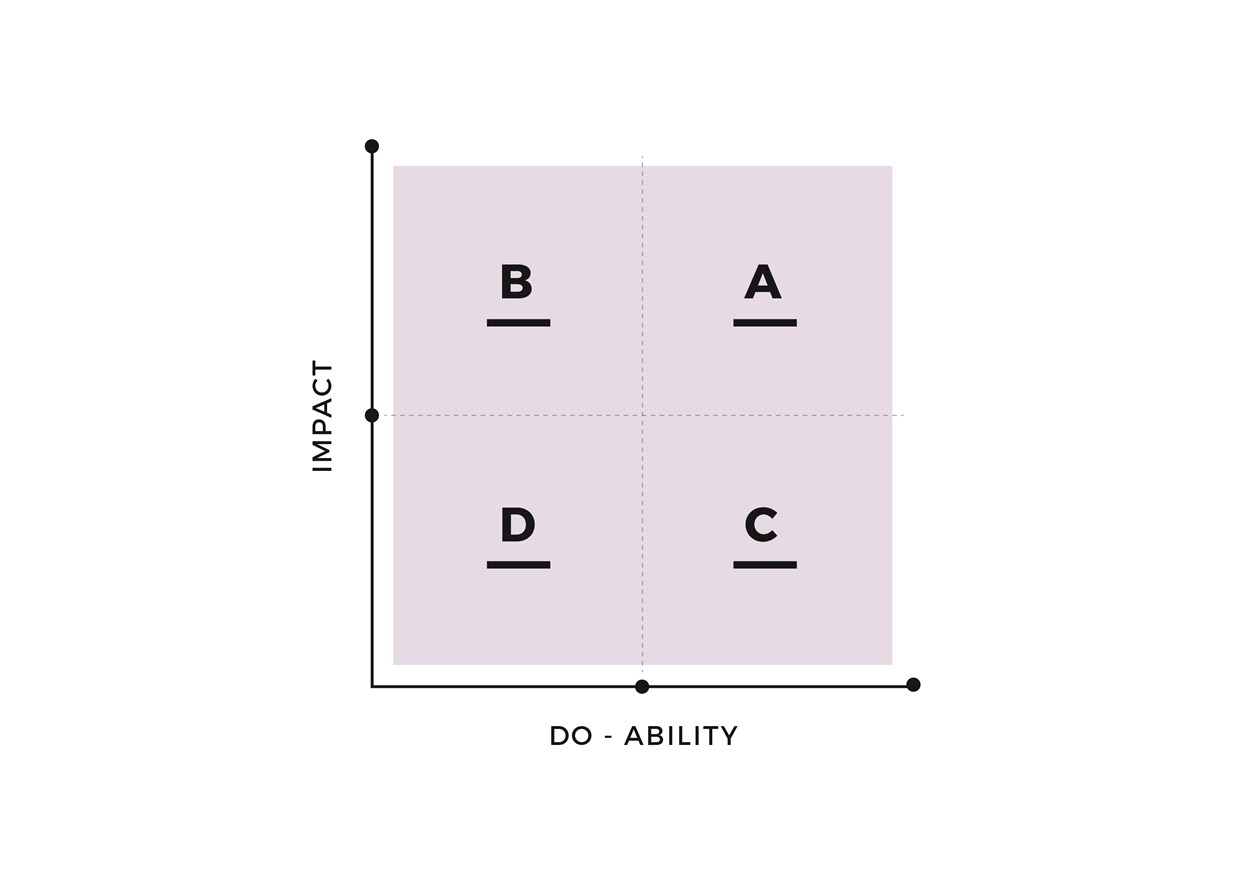Most people can set a destination and create a to-do list. They've got a view about how an organisation could be developed for the better. Unfortunately, in my experience, the list is often long and the destination impossibly far away.
Plotting the path a journey should follow takes craft. You need to work out not only what needs to be done, but also how, in what order and with whose support.
I’ve lost count of the number of people who are new to a role and say to me: “I know what needs to be done, but I’m struggling with what to tackle first and where to invest my energies.”
There’s a fairly simple tool you can use as a framework for prioritising change:

Box A - High Impact & Easy
These are often quick wins, small things that make a big difference. They’re not necessarily sexy or complex, but they’re actions that will make a tangible difference in the organisation. This work is often define by shorter time horizons, making it quick to implement and yield obvious benefits.
In young organisations, this box is often full. That's what makes them attractive organisations to work with for many. In more mature organisations, there's often less in this box – what is here is often technical or procedural.
A word of caution: be honest when assessing impact and do-ability. Don’t underestimate or oversell it. An initiative’s relative ease doesn’t mean it doesn’t need planning properly. In fact, work of this sort that is poorly planned often increases in difficulty and reduces in impact.
Approach: Get things moving. Actions in Box A are a great way of building appetite and confidence.
Box B: High Impact & Harder to Implement
This is often longer term, more complex work which is defined by longer time horizons. Significant rewards are on offer but these generally come hand in hand with similarly significant risks.
In most organisations, it is often the extended timescales that make these initiatives difficult to execute; getting any organisation, especially a young one, to think in the medium term is tough. The tendency is to get caught up in annual goal-setting, at the expense of everything else. This work is often around strategy and culture.
The key question is here is how do you manage or reduce the risk without diminishing the level of reward? Can the activity be broken up into smaller chunks? Could some of those chunks be included in box A?
Would completing an activity from Box A or C (these are easier to implement) build sponsorship, support and organisational readiness to help reduce the risks associated with this activity?
A word of caution: Don’t over-engineer it. Set sensible timeframes and simplify where you can, dividing the change into manageable and definable stages. Be realistic about how long it will take but make sure the timescales are meaningful organisationally. Keep in mind that a five year change plan may not work in a young technology business, for example – the world is likely to have moved on by the time you reach the end of the plan.
Approach: Take time to build momentum for this work. Plan but don’t over-engineer. Everything in small chunks.
Box C: Easy and Lower Impact
Initiatives in this box are often pet projects – yours or other peoples’. There is often a lot of this sort of change activity in technical and specialist areas such as Finance, IT and HR.
The work is often ‘tidying’ activity that can increase professionalism and coherence and be quite motivational to some within its immediate sphere of influence.
Due to their relative ease, completing these activities can often serve as a good motivational prompt that will allow you to build the leadership, support and personal credibility you need to attack higher impact activity.
A word of caution: Make sure you have sufficient resource before going ahead with initiatives in Box C.
Approach: Helpful for tidying up. Activities in this box can be a good investment, laying the foundation of support for more impactful change in the future.
Box D: Low Impact, Low Do-ability
This work differs from initiatives that fall into Box C, in that it doesn’t even have the redeeming feature of being motivational to some. It’s often someone’s solution in search of a problem.
You may find yourself doing these activities because they’ve become a part of your ‘toolkit’ – you’ve done them before and they’ve become habitual, rather than being relevant or useful in a specific situation.
They are often a justification of someone’s existence and/or a vehicle for avoiding more impactful or more difficult change, allowing 'busy fools' to give the illusion of effort without actually achieving anything of worth.
A word of caution: Activities in Box D bleed resource, and any investment here is simply wasteful. Take a look at your own habitual ways of doing things to make sure they don’t fall into this area.
Approach: Avoid this activity completely.


